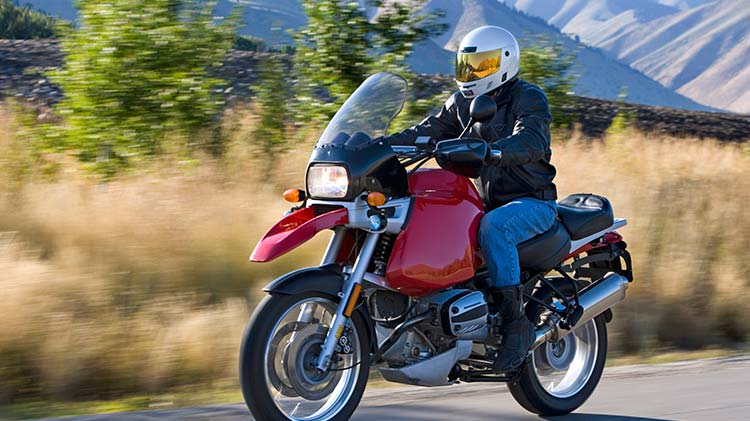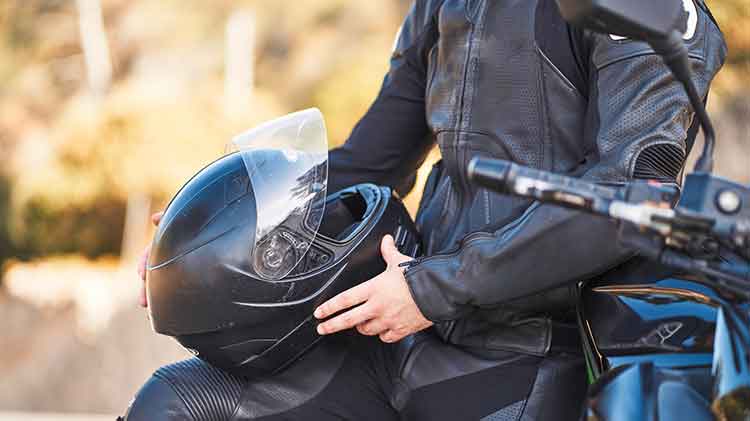Moped, scooter, e-bike & motorcycle differences
Find out the differences between a moped, scooter & e-bike — do they need motorcycle insurance and a license?
Ease of use, lower gas consumption, less maintenance and nimble size: There are many reasons people might consider motorized two-wheeled options such as scooters, mopeds and e-bikes for driving short distances. Before making a decision, you may want to understand the differences between them and a motorcycle and to familiarize yourself with regulations governing all four. And more importantly, if they require a motorcycle insurance policy or license to ride.
What’s the difference between a moped, scooter, e-bike and motorcycle?
Moped
First named because it was a bicycle with a motor (literally a motorized pedal vehicle), today's mopeds have a step-through frame (with or without pedals), small wheels (typically 10 inches) and have a 50cc (cee-cee is moto-speak for cubic centimeter) or smaller motor.
Mopeds generally top out at 28 mph (less with increased rider weight) and may achieve triple-digit gas mileage.
Scooter
A scooter (motor scooter) has the same step-through frame and smaller wheels like a moped, but a more powerful motor — 50cc - 250cc. Scooters usually have automatic transmissions and come with lights, turn signals and horns.
Scooters offer superior mobility with higher top speeds and good gas mileage. For example, a 150cc scooter has a top speed of 60 mph and may get up to 70 mpg, while a 250cc scooter can reach 75 mph but might get fewer than 60 mpg. However, you may not be able to use a scooter on the freeway. Check with your local DMV regarding size or horsepower minimums.
Have an agent contact me
with a quote
E-bike (electric bikes)
Electric bicycles have pedals, an electric motor and have no more than 750 watts.
There are different types of e-bikes:
- Class 1: Motor activates when the rider is peddling. The motor is also capped at 20 miles per hour.
- Class 2: Same as a Class 1, but the motor can propel the rider without any peddling.
- Class 3: Same as a Class 1, but has a speedometer and the motor is capped at 28 miles per hour.
If you think an e-bike is right for you, review some of our e-bike safety tips.
Motorcycle
The bike's design is what distinguishes a motorcycle. The engine and gas tank are forward and between the driver's knees. Motorcycles usually have a manual transmission in which drivers need to use a clutch and shift gears. Motorcycles typically have 16-inch tires and the driver sits upright with their back perpendicular to the road.
Motorcycles generally have an engine size that enables them to share the road with other motorized vehicles.
Do you need insurance for a moped, scooter or e-bike?
Coverage will depend on which you purchase. Mopeds, e-bikes and scooters may require liability insurance and each state may differ in their requirements. You may also choose to add comprehensive coverage which normally covers vandalism, theft or storm damage. Contact your local insurance agent to confirm.
Homeowners policies may provide a limited amount of liability and coverage for potential property damage or theft for your scooter, electric bike or moped. But criteria such as cost of replacement, cost of parts and size of motor may require them to have a separate policy. Discuss what your homeowners policy may cover for these vehicles with your agent.
Do you need a license?
Your state regulates licensing requirements. Check local regulations; they may vary from one locale to the next, and license age and requirements could be different for each motorized two-wheeled option. Your state may offer a two-wheeler education course and/or require a skill's test.
License plates and registration requirements may also be determined by engine size.
Do you need a license to drive a moped?
If the engine is 49cc or less, many states require only a vehicle driver’s license or driver’s permit. A motorcycle license may be necessary if the moped has an engine capacity of 50cc or more. Please check your state’s licensing requirements.
Do you need a license to drive a 49cc scooter?
Scooter laws are similar to mopeds, where scooters under 49cc can be ridden with a vehicle driver’s license. In many states, when the scooter is 50cc’s or more, a motorcycle license is required. Please check your state’s licensing requirements.
Do you need a helmet?
Many states require helmets for motorcyclists under a certain age. If they aren't required, consider helmet use for you and your passengers for added safety. Check your state and local laws for helmet regulations.
What are some rules of the road?
- Moped and e-bikes: The slower speeds mean it is not legal to ride on highways and is best used for shorter trips around town on low-speed-limit roads.
- Scooters: Depending on engine size, these can go faster and might join highway traffic if allowed in your locale. However it may be better to use a scooter for shorter distances rather than the highway since you'd be sharing the road with larger and heavier vehicles that go much faster.
Regardless of what you’re riding, motorized riders need to obey the same traffic and safety laws as all other vehicles. States like California also prohibit passengers on mopeds and e-bikes. In addition, most cities prohibit their use on sidewalks and walking trails. Check with your local DMV for any specific rules in your area.
What about emissions?
While two-wheelers may have better gas mileage, their emissions may be less than stellar. According to Gear Junkie, motorcycles from the 2000s produce over 3,000% more nitric oxide and over 8,000% more carbon monoxide than their vehicle counterparts. Today, many are manufactured with emission-reducing technology. If emissions are important to you, ask before you buy.
If you are in the market for a moped, scooter or e-bike, understand the differences between them, the rules of the road and the requirements of your state. Also consider talking to a State Farm® agent about what the best coverage for your new ride is, whether it is homeowners, motorcycle or another type of policy. And don't forget to consider liability insurance and learn about the additional protection it may provide.



